|
Visiting
German vineyards, part 3
Dönnhoff, Nahe

Our
next visit was to one of German wine’s living legends: Helmut
Dönnhoff, in the Nahe. Helmut began in 1971 with 4 hectares of
vines, and now has 20 hectares, with holdings built up step by step.
‘It was a long way’, he recalls. Now he’s celebrated as one of
Germany’s very best producers. ‘Most people in wine today make
it for business’, he says. ‘I make it for me, myself’. I asked
Helmut about the secret to his success. He compares it with music.
‘There are many wonderful scores, but only a few people can
interpret them well. Or it is like a chef: people have the same
ingredients but each chef brings another taste to them’. He claims
that it is not difficult for him to understand what to do with the
grapes his terroirs give him. ’For me it is an open book: it seems
simple’.
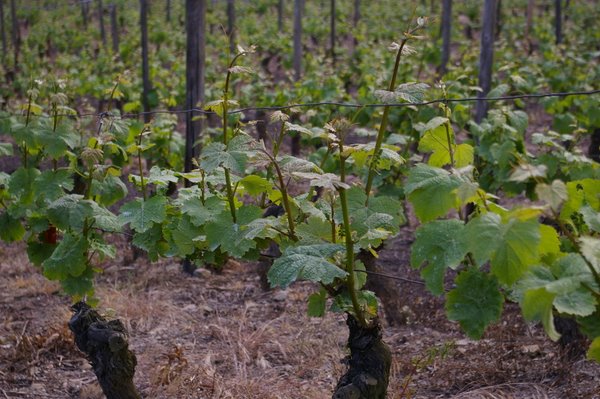
Vines in the Hermannshole vineyard
A
word about the Nahe. Altogether Germany has around 100 000 hectares
of vines, and the Nahe contributes about 4000 of these, so it’s
not a huge region. Only a quarter of the Nahe is planted to
Riesling, and the Riesling bit is the middle Nahe where Dönnhoff is
located. As well as Riesling, Helmut makes Pinot Blanc and Pinot
Gris (together 20% of his production). These are grown on the more
loamy soils, as they need more water in the summer. Both the Pinots
ripen earlier than Riesling, and Riesling’s preference is for
stonier soils with less loam.
‘This
is not a region for more opulent wines: it is more for elegance’,
says Helmut. As with many producers, he splits his production
between the dry and fruity styles. ‘The fruity style has more
ageing potential because the alcohol isn’t so high’, Helmut
claims. ‘After 10 or 20 years you don’t taste the sugar as sweet’.
He used to think that the dry styles didn’t age so well, but now
he thinks that may be changing as people begin to make them from
their best sites. ‘We used to use the best grapes for the fruity
style, but in the last 10 years the fashion has shifted to dry
wines. Now high class dry wines are being made. Global warming has
meant that acidity is lower and the grapes are riper, so the quality
of wines has improved’. Helmut reckons that 10 years ageing isn’t
a problem for the dry wines, but that 20 years is probably too long.
He cites figures showing that between 1988 and now, the average
temperatures have increased by a degree, and flowering is a week or
10 days earlier.

Felsenberg
2007
was a year for Spätlese, whereas 2008 is a year for Kabinett. ‘I
want global warming to stop now’, he says. ‘It’s perfect; we
are the winners at the moment’. He says he hasn’t had a bad
vintage since 1988.
Winemaking
is straightforward. Whole bunches go into the press within 3 hours
of picking. The juice is then settled for 10–18 hours. ‘I don’t
want the juice too clear, so I don’t settle too much’, he says.
‘Juice needs a little bit of solids. It depends on the year and
the vineyard’. Helmut says that he always tastes the juice. ‘You
can’t look in the book and say that it is the right way’. He
says that in Australia and New Zealand they don’t like oxidation
of the juice, and work with juice that it too clear, which makes it
difficult to start fermentation easily. Fermentation then takes
place in casks or stainless steel tanks For healthy grapes he’ll
use a natural ferment but for botrytized grapes he’ll inoculate
with cultured yeasts. It’s important that fermentation starts
within three or four days of pressing, and if it doesn’t, he’ll
inoculate. Fermentation temperature is 25–30 °C (Helmut thinks 18
°C is not a natural way to make wine). It is important that the
casks are not too big so fermentation can start in time: 1000 litres
is great, and 2000 litres is OK. Wines fermented in wooden casks
typically spend 2–3 months in cask and then go to stainless steel.
The wine spends 1 month on gross lees and 3 months on fine lees. In
March the wines are filtered, and they are bottled a month or two
later.
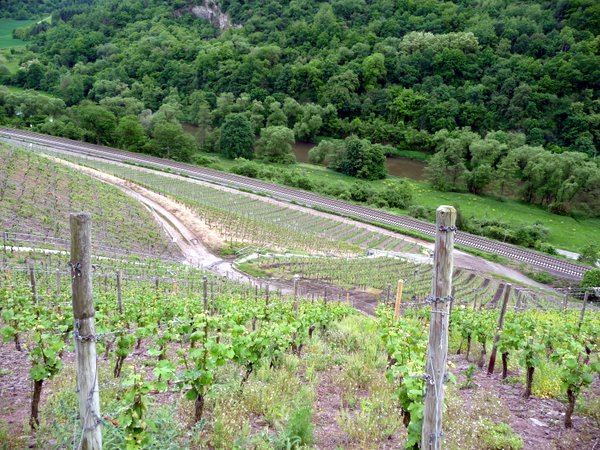
Felsenberg
| 2008
Vintage Report |
| "Just
as with 2007, flowering time was early, but it was one week
later in 2008 than 2007. This is still one week earlier than
average, which is in the first two weeks of June. We had a
normal German summer: it was not cool, but not so hot either,
with some sun and some rain. The temperature data show that it
was actually quite a warm year when compared to the average.
Everything happened a week or two earlier than average in the
vines, and ripeness was advanced by a week. Then in September
we had very cool nights, and it was a cool month overall,
which slowed ripening. By the middle of September we were back
to normal in terms of the vegetative cycle, although ripeness,
sugar levels and acidity were all high. Most people picked too
early with too hard acidity. Picking on sugar levels only,
people could have started at the beginning of October, like a
normal year, but the acidity at this stage was too high and
the grapes too green. If you tasted the grapes then, they
weren’t properly ripe. We had thought that the harvest would
be at the end of September and had asked the Polish workers to
come then. So we had 25 workers here and no work for them in
the first two weeks of October.
It was very stressful. We kept going out tasting grapes
and although the sugars were fine we couldn’t pick. Then
from mid-October they started tasting better and better, so we
started picking. Pinot Blanc was picked 10–15 October, and
on 20 October we started picking Riesling. There were no
problems with botrytis and the weather was stable during
harvest with very healthy grapes. At the beginning of November
we had rain, but we had picked everything by the end of the
first week of November. Everything had been harvested in 2–5
weeks. The grapes
were healthy so we didn’t need to do much selection. It wasn’t
a good year for Auslese, but we have lots of high class
Auslese from previous years, so in 2008 we were looking for
high-class Spätlese and below. We left some grapes for
Eiswein and had some good conditions for picking it: –11 °C
on 31 December and –18 °C on 7 January.
" |
‘We
are looking for the talents of each vineyard’, says Helmut. ‘For
example, Kupfergrube is too ripe for Kabinett, but the acidity is
too hard for dry wines. Brücke is a special microclimate near the
river whose talent is not for Kabinett and dry wines but for
Spätlese, Auslese, Beerenauslese and Eiswen. It has a high
temperature differential between day and night, and it is a
problematic vineyard in a cold year. It is the last vineyard to be
picked.’
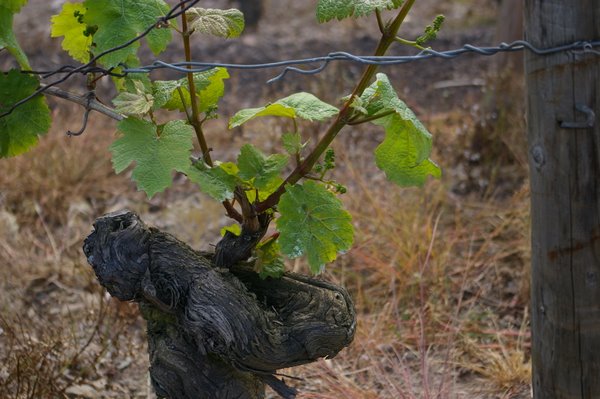
‘Riesling
has two talents’, he continues. ‘I like it very young. It is
wonderful to drink these wines young and fresh on a warm day. But
don’t drink it all in the first two summers after the harvest.
After 3 or 4 years the wine goes to sleep, and then after 6 or 7 it
comes back. So I like it in the first two or three years and then
after 10’.

We
looked at some vineyards. It was a gorgeously still, warm May
evening. First stop was the Niederhauser Hermannshöle (above),
an 8 hectare slatey-soiled vineyard of which Helmut has 2 hectares.
From the vineyard the village of Oberhäus, where Helmut is based,
is visible, as is the Leistenberg vineyard in the far distance.
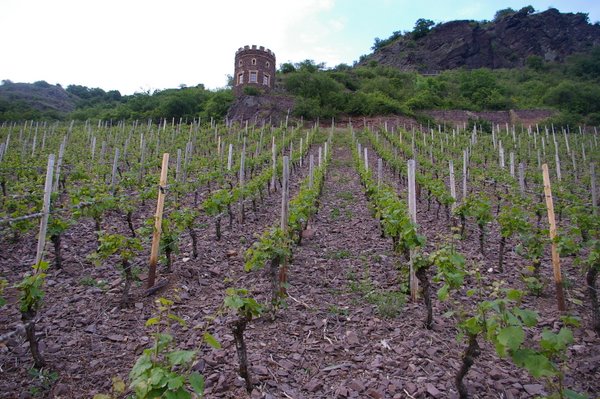
The
second stop was in the Felsenberg vineyard, which has volcanic
soils, described as porphyry. The first bit of this vineyard we
viewed was a special section called Felsentürmchen (above),
and the second bit had a different exposition and steeper slopes (below).
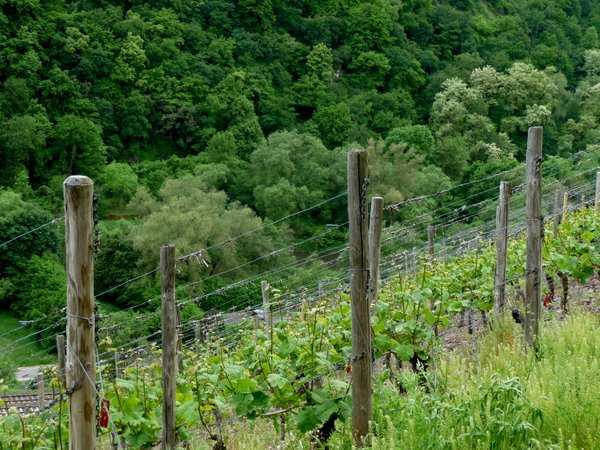
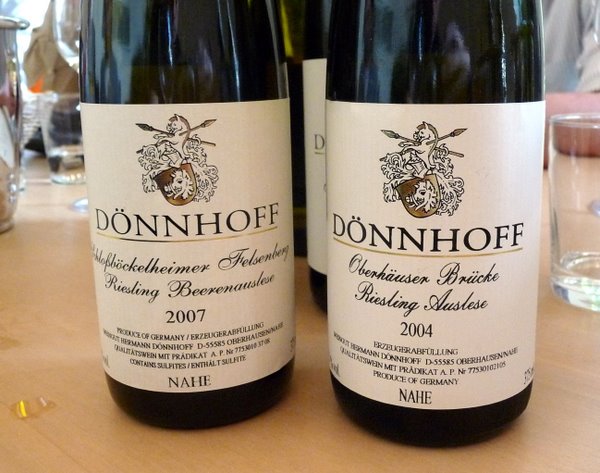
THE
WINES
Dönnhoff
Riesling Trocken 2008 Nahe
From
the Felsenberg vineyard with its volcanic soils. Beautifully
expressive, elegant, aromatic Riesling. Dry with lots of minerality
and fresh lemony fruit. Fine and expressive with good acidity. 11.5%
alcohol, rrp £12.95). 90/100
Dönnhoff
Pinot Blanc Trocken 2008 Nahe
Full
yellow colour. Fresh, taut, herby nose with citrussy fruit. The
palate is crisp and mineral ic with lovely freshness and a creamy
edge to the herby, lemony fruit. Lovely. 90/100 (£14.40)
Dönnhoff
Pinot Blanc Trocken 2007 Nahe
Taut,
herby, creamy, minerally and precise with lovely intensity and
freshness. Very bright. 89/100
Dönnhoff
Pinot Gris Trocken 2008 Nahe
Mineralic
nose with some grapey notes. The palate shows lovely broad grapey
notes with a hint of smokiness and nice minerality. Long, minerally
finish. 89/100 (£14.95)
Dönnhoff
Tonscheifer Riesling Trocken 2008
From
soft slate soils in the Leistenberg vineyard, 11.5% alcohol.
Beautifully aromatic nose with hints of honey, minerals and lemon.
The palate is beautifully bright showing expressive melon and citrus
fruit. Really expressive with good acidity. 92/100
(£16)
Dönnhoff
Riesling QbA 2008 Nahe
B
eautifully expressive and vivid with explosive lemony fruit. Sweet,
appley, intense lemony palate with high acidity. Off-dry. 89/100
Dönnhoff
Krötenpfuhl Riesling Kabinett 2008 Nahe
Lovely
depth here: taut, honeyed, appley with citrus depth. Really focused
with some sweet melony notes. Finishes fresh and mineral. Beautiful
concentration. 91/100
Dönnhoff
Oberhäuser Leistenberg Riesling Kabinett 2008 Nahe
8.5%
alcohol. Refined, creamy, limey nose is fresh and minerally. The
palate is beautifully elegant with minerally freshness. Beautifully
limey notes with rich texture and great balance. This site has a
southeast exposure – in the 1970s and 80s this wasn’t a top
vineyard, but global warming has changed this. Morning sun dries the
vineyard and then in the afternoon it isn’t too hot. 93/100 (£16)
Dönnhoff
Oberhäuser Leistenberg Riesling Kabinett 2007 Nahe
Precise,
limey and a bit spicy with lovely focus and some richness. Limey,
minerally, intense and off-dry. Lovely stuff. 92/100
Dönnhoff
Felsenberg Riesling Trocken 2008 Nahe
Very
fresh and minerally with some honey and lemon notes. Persistent,
crisp and fruity. Quite pithy with a dry finish. Lovely minerally
style. 91/100
Dönnhoff
Felsentsürmchen Riesling Spätlese 2007 Nahe
Lovely
rich, sweet, intense limey Riesling with great precision, depth and
limey complexity. Vibrant and alive with great depth. Lovely length
and complexity. 92/100
Dönnhoff
Norheimer Kirschheck Riesling Spätlese 2008 Nahe
A
wonderfully pure, intense, fresh wine. Linear and minerally with
great purity, superb acidity and real focus. Sweet yet light and
precise. Brilliant. 94/100
Dönnhoff
Scloßböckelheimer Kupfergrube Riesling Spätlese 2008 Nahe
Volcanic
soils, 8.5% alcohol. Lovely lemony, melony nose is pure and
aromatic. The palate is concentrated and intense with lovely bold
lemony fruit. Sweet and pure. Wonderful wine that’s beautifully
expressive. 95/100
Dönnhoff
Oberhauser Brücke Riesling Spätlese 2008 Nahe
A
1 hectare monopole, with slate and loam soils. 8.5% alcohol.
Amazingly fresh, taut and limey. Super-fresh with explosive acidity
countering the sweetness brilliantly. Quite elegant with lovely
minerality and a long finish. Beautiful purity here. 94/100 (£29)
Dönnhoff
Niederhäuser Hermannshöle Riesling Spätlese 2008 Nahe
Slate
soils. Fresh, minerally nose. Very fresh, intense limey palate with
high acidity. Intense and limey with real freshness.
Youthful and fresh with potential for the future. 93/100
Dönnhoff
Niederhäuser Hermannshöle Riesling Trocken Grosses Gewachs 2007
Nahe
Wonderfully
precise and mineralic with lovely intensity of taut lime, pear and
grapefruit characters. Very refined and intense with lovely
complexity. 93/100
Dönnhoff
Niederhäuser Hermannshöle Riesling Auslese 2006 Nahe
Rich
and intense, with sweet lemony fruit and melony, apricotty depth.
Rich but fresh, with lovely bold flavours and great precision.
92/100
Dönnhoff
Delchen Riesling Trocken
Grosses Gewachs 2007 Nahe
Brooding
lime, apple and honey nose is quite sweet with a mineral character.
The palate is explosively rich and pure with beautifully focused
lime and mineral complexity. Very pure and intense with lovely
lemony finish. Quite dry. A brilliant effort. 94/100 (£35)
Dönnhoff
Oberhäuser Brücke Riesling Auslese Goldkapsule 2004 Nahe
7.5%
alcohol. Wonderfully intense sweet melony, minerally nose. The
palate is concentrated with amazing depth of lemony, minerally
flavours. Explosive. Intense and broad with great depth and
complexity. 96/100
Dönnhoff
Schloßbockelheimer Felsenberg Riesling Beerenauslese 2007 Nahe
8.5%
alcohol. Beautifully pure melon fruit nose with some apricot and
honey notes. The palate is viscous but pure with amazingly linear
fruit. Viscous, very sweet, super pure and ethereal. This had some
botrytis but not much, and Helmut describes it as dry, fine
botrytis. 95/100
Now
for two Eisweins. ‘It’s very important to have a top vineyard to
make Eiswein’, says Helmut. ‘From a bad vineyard you concentrate
the bad flavours’. Everything is concentrated by freezing: both
sugar and acidity. The grapes are protected from the birds by a
perforated plastic sheeting. For picking, temperatures must be at
highest –7 °C, but can’t be below –16 °C or you won’t get
anything during pressing.
Dönnhoff
Oberhäuser Brücke Riesling Eiswein 2002 Nahe
7.5%
alcohol. Yellow gold colour. Flavours of rich, honeyed crystalline
fruit. Melony. Superconcentrated palate with viscous peach, apple
and spice notes. Supersweet, but has high acidity. Amazing
concentration and depth. 14 g/l acidity, 400 g/l sugar. 95/100
(£108 per half bottle)
Dönnhoff
Oberhäuser Brücke Riesling Eiswein 2008 Nahe (tank sample)
Still
cloudy. Immensely sweet, intense and fruity. Incredibly bold and
complex with great purity. Wonderful. 14.5 g/l acidity,420 g/l
sugar.
GERMANY
SERIES
 Part
1: Introduction Part
1: Introduction
 Part
2: Leitz, Rheingau Part
2: Leitz, Rheingau
 Part
3: Dönnhoff, Nahe Part
3: Dönnhoff, Nahe
 Part
4: Gunderloch, Rheinhessen Part
4: Gunderloch, Rheinhessen
 Part
5: Paul Furst, Franken Part
5: Paul Furst, Franken
 Part
6: Dr Loosen, Mosel Part
6: Dr Loosen, Mosel
Wines
tasted as 05/09
Find these wines with wine-searcher.com
Back
to top
|

